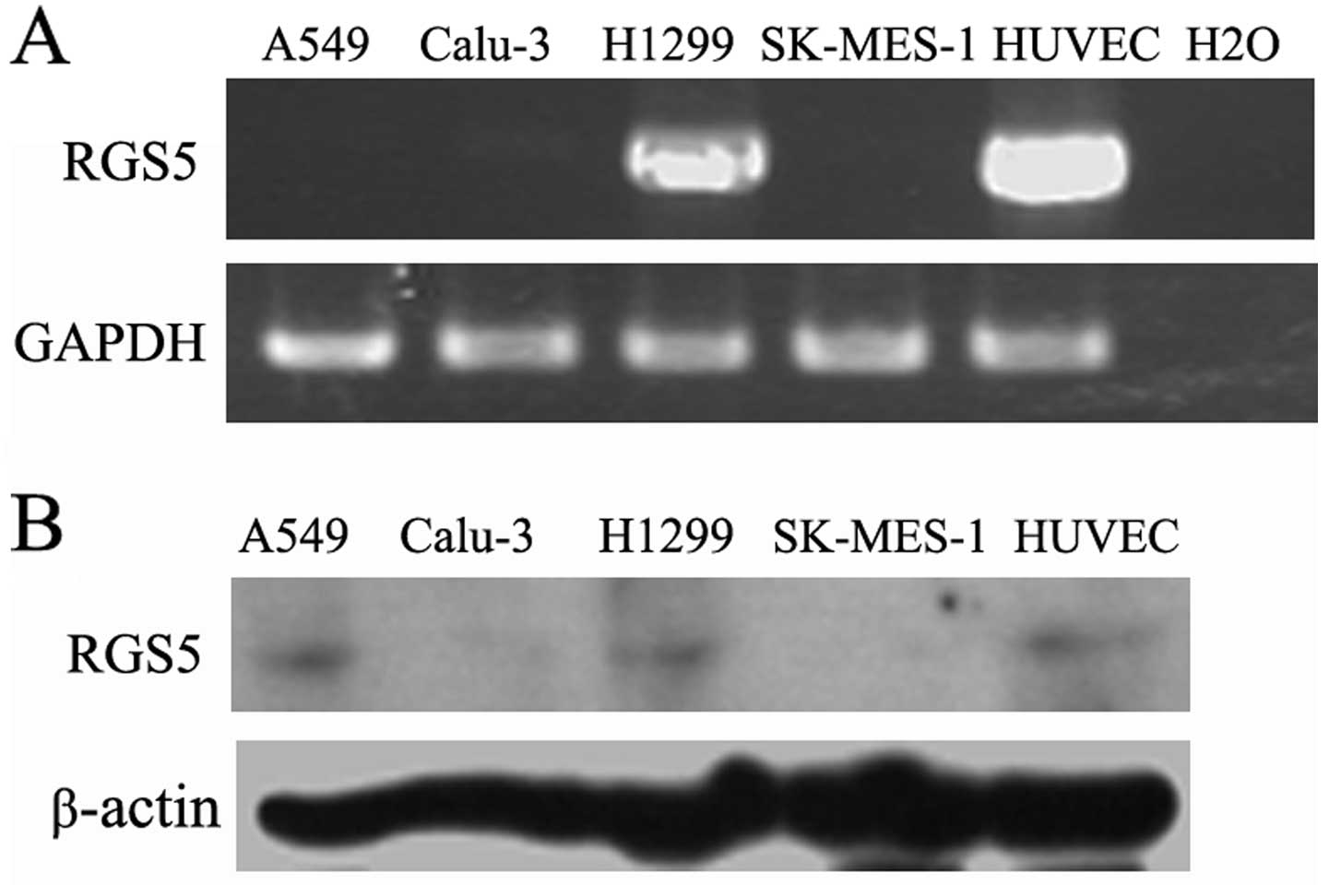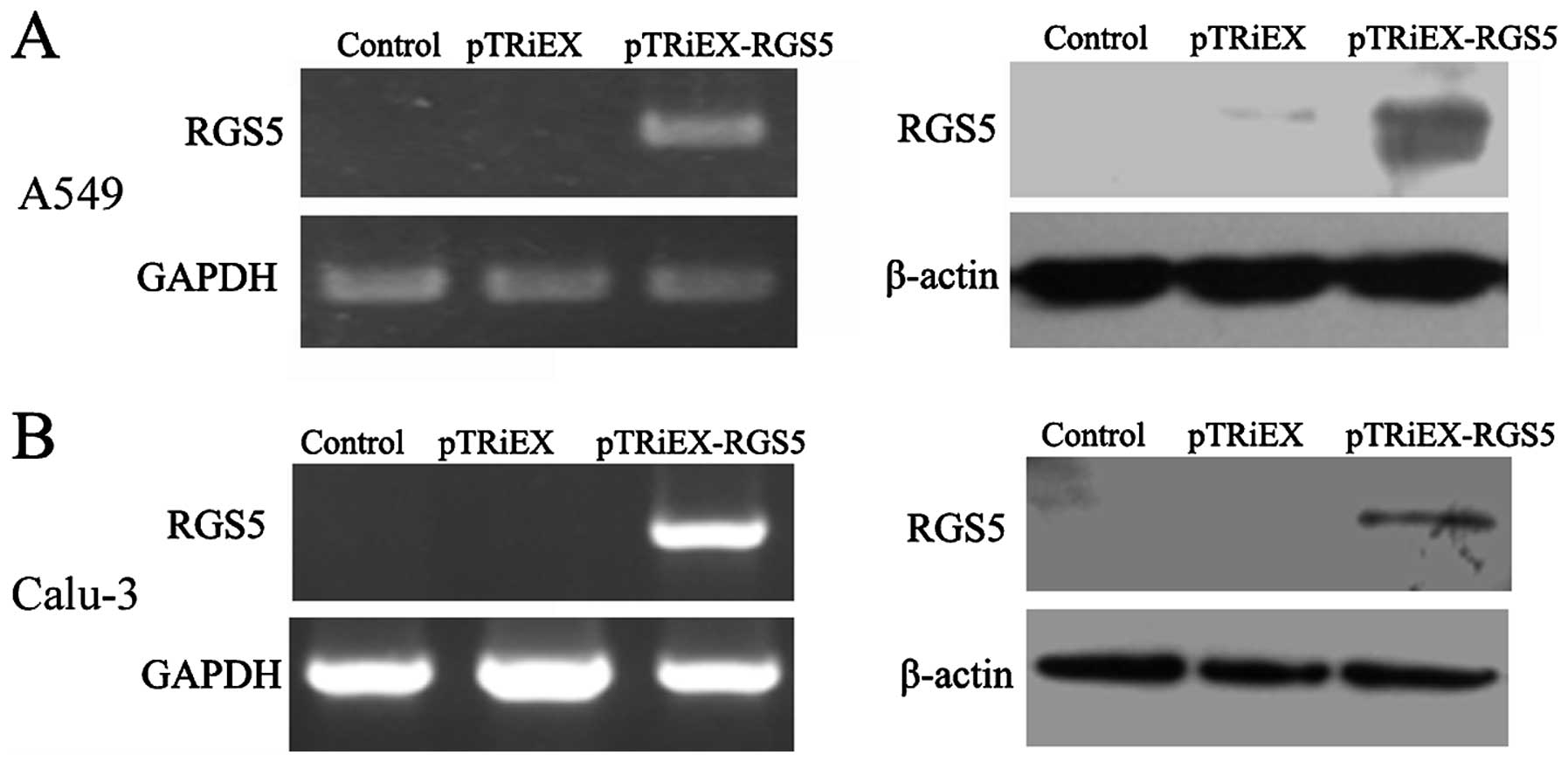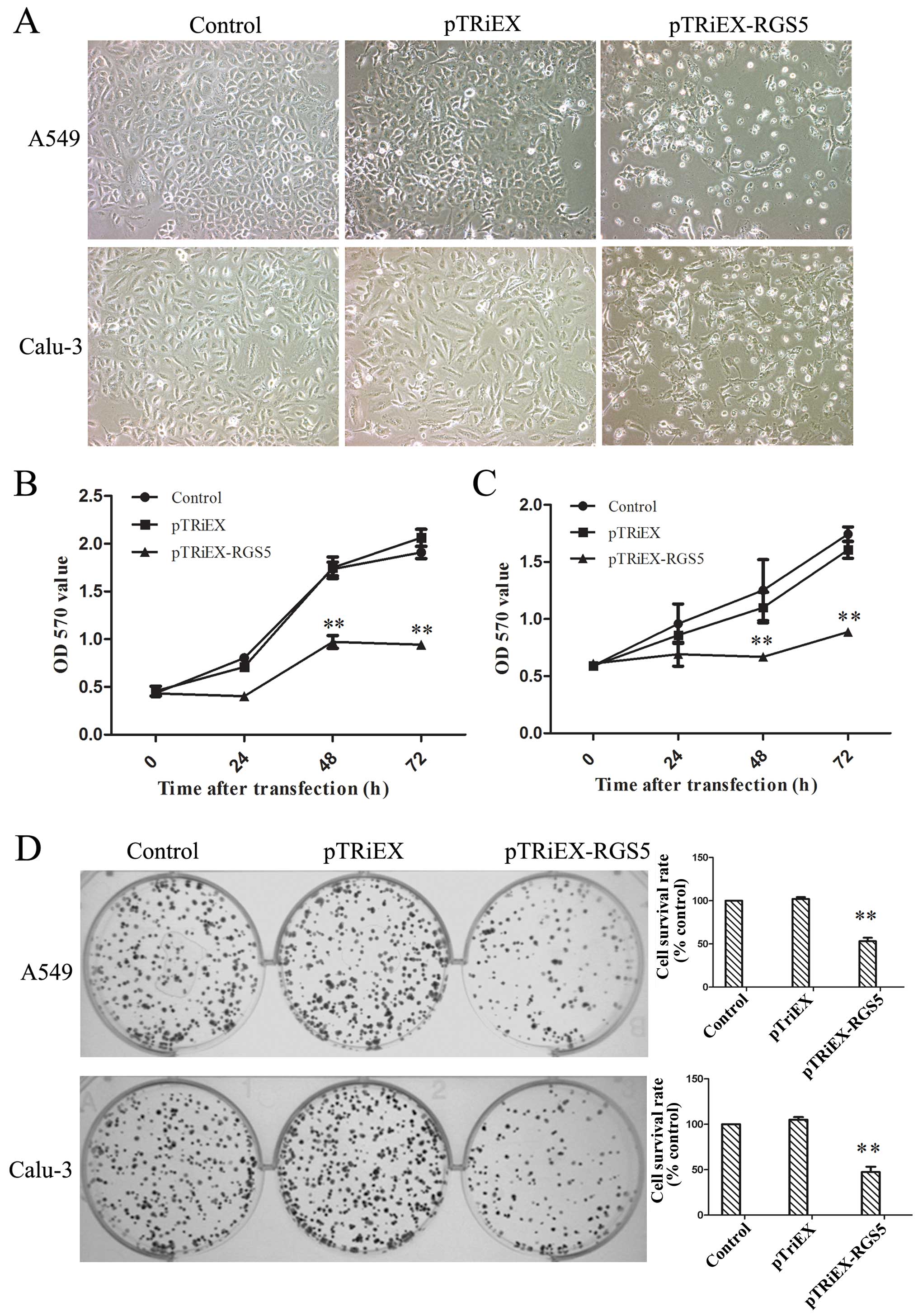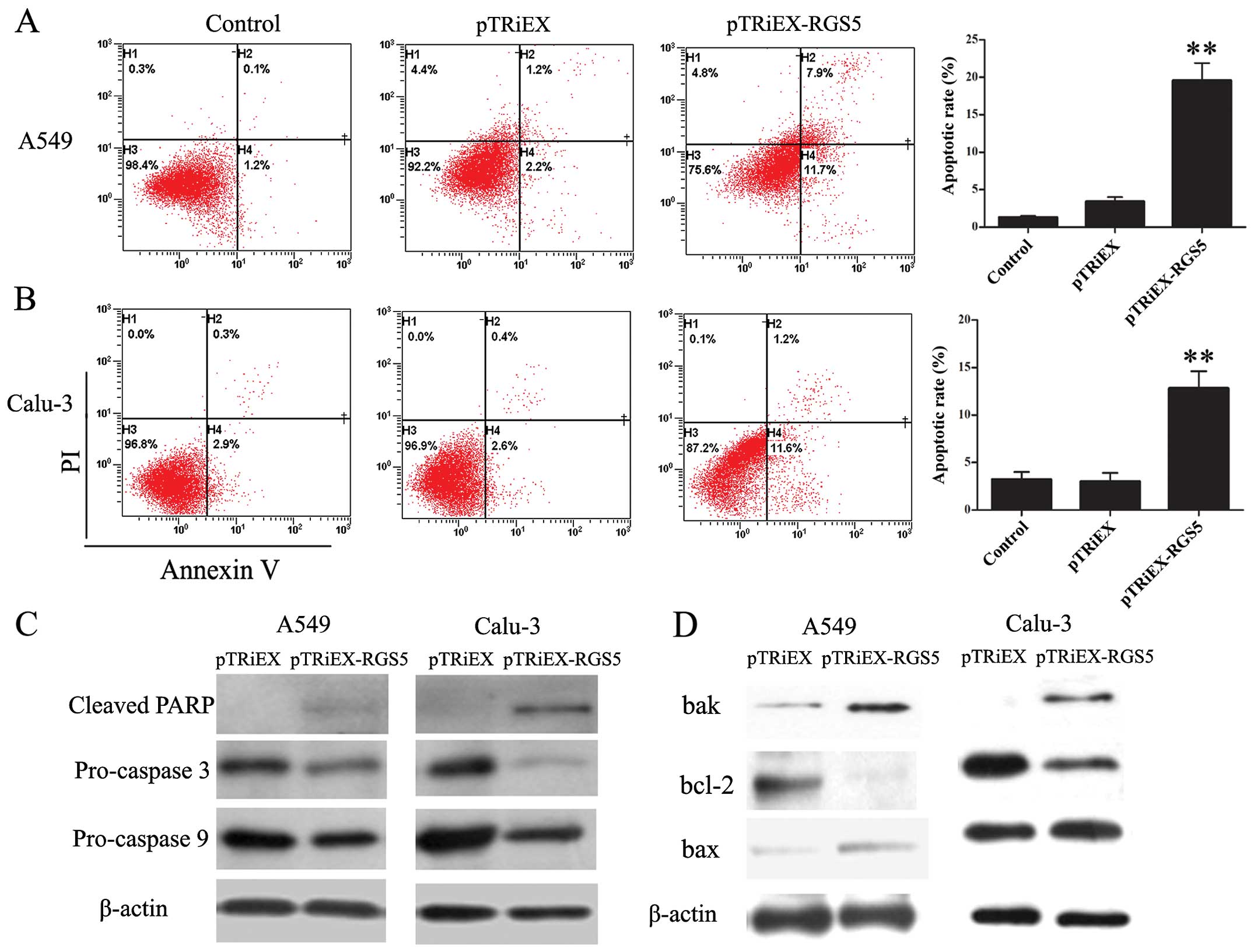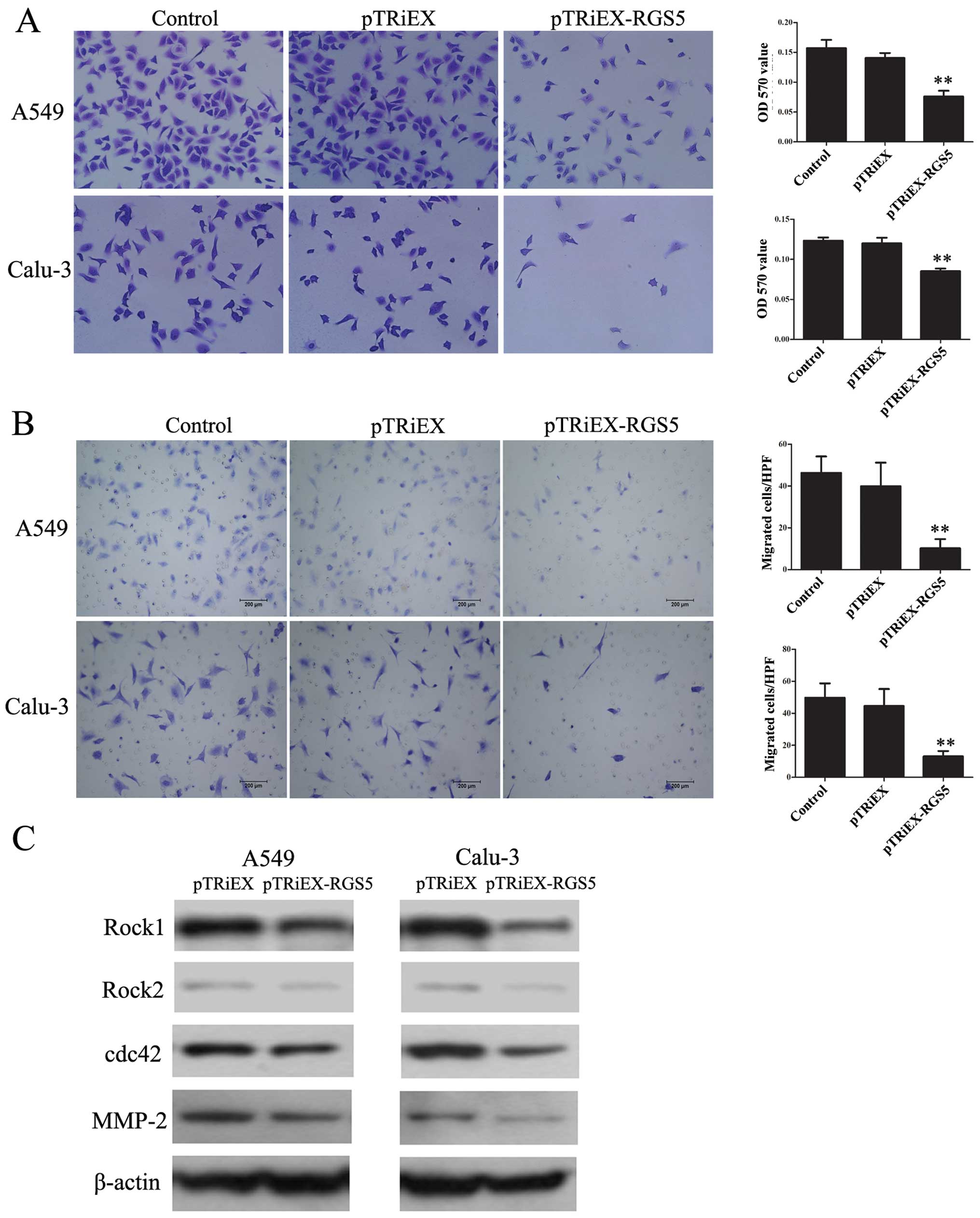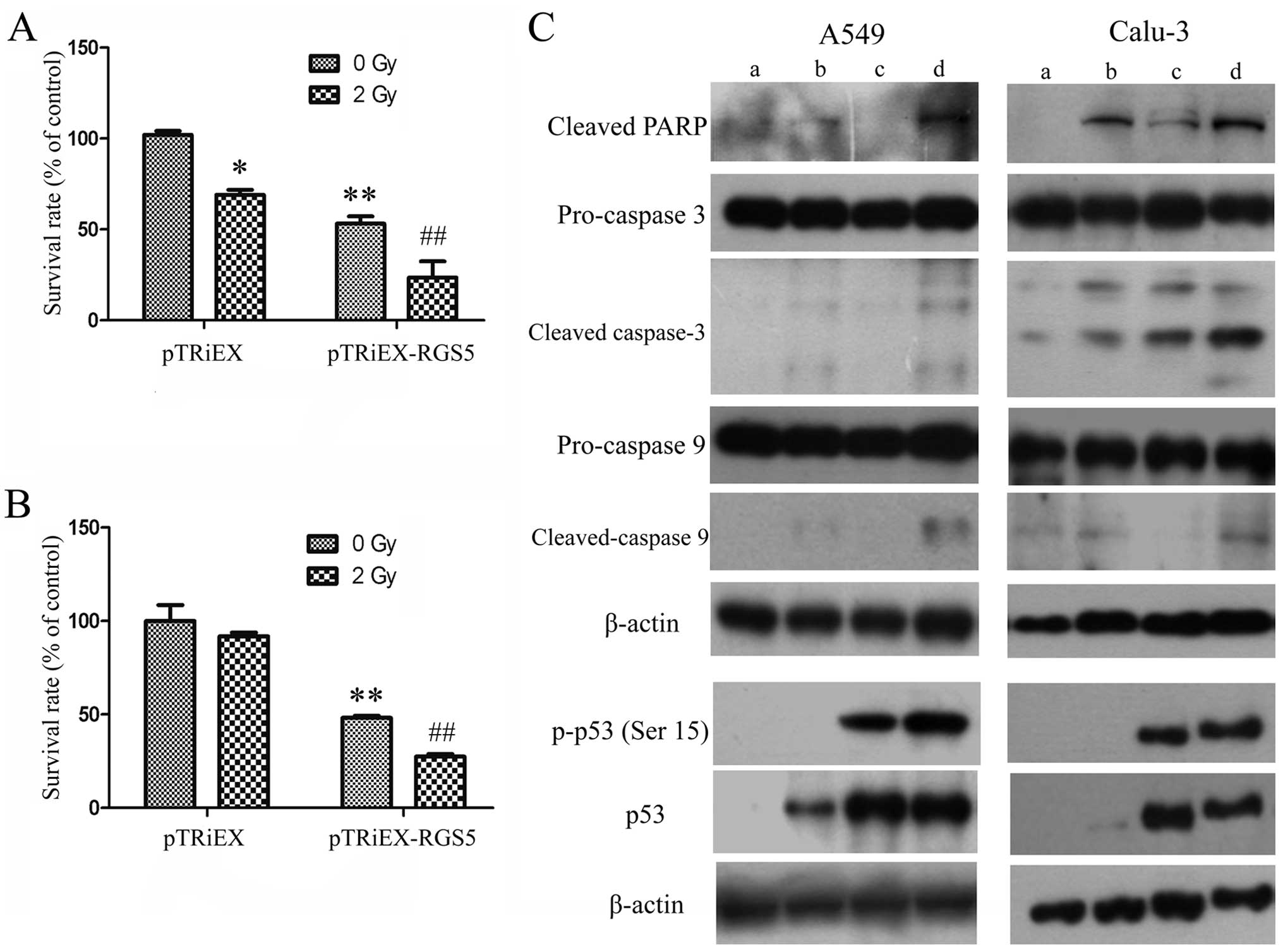Overexpression of the regulator of G-protein signaling 5 reduces the survival rate and enhances the radiation response of human lung cancer cells
- Authors:
- Published online on: April 20, 2015 https://doi.org/10.3892/or.2015.3917
- Pages: 2899-2907
Abstract
Introduction
Regulator of G protein signaling (RGS) proteins is a family of GTPase activating proteins, which interact directly with α subunit of heterotrimeric G proteins to accelerate the GTP hydrolysis activity of the α subunit and negatively regulate the G protein signaling (1,2). All the RGS family members contain an essential 120-amino acid RGS domain. Regulator of G protein signaling 5 (RGS5) belongs to the R4 subfamily of RGS proteins, which consists mostly of small RGS proteins containing only short sequences beyond the RGS domain (3). RGS5 expression is abundant in pericytes and vascular smooth muscle cells (4,5) and high levels of RGS5 have been detected in the heart, lung, skeletal muscle and small intestine, while lower levels have been found in the brain, placenta, liver, colon and leukocytes (6). RGS5 has been implicated in many pathophysiological processes including cardiac hypertrophy (7), blood pressure regulation (8), atherosclerosis (9,10), lipid metabolism (11), bronchial smooth muscle cell contraction and asthma (12). RGS5 was markedly downregulated during the endothelial cell morphogenesis in an in vitro human capillary tube formation model (13). RGS5 levels were elevated in pericytes during wound healing and ovulation, suggesting a strong correlation between the RGS5 expression and the active vessel remodeling (14,15).
Substantial evidence indicates an active role of RGS5 in tumor angiogenesis. RGS5 is found highly expressed in the vasculature of several tumors. RGS5 mRNA is expressed in the endothelial cells of tumor vessels, but not in the endothelial cells of the normal tissues in renal cell carcinoma (RCC) (16), hepatic cell carcinoma (HCC) (17) and ovarian carcinoma (18). RGS5 mRNA is specifically upregulated in the vasculature of premalignant lesions during the ‘angiogenic switch’ and further elevated in tumor vessels in a mouse model of pancreatic islet cell carcinogenesis (14). Elevated expression of RGS5 has been reported in tumor cells in gastric tumor (19), parathyroid (20) and non-small cell lung cancer (NSCLC) (21). Yet, the fundamental role RGS5 played in the neoplasm and its mechanisms are still to be clarified.
In the present study, we investigated the potential role of the high levels of RGS5 in human lung cancer cells and further explored the underlying molecular mechanisms.
Materials and methods
Ethics statement
The present study conforms to the principles outlined in the Declaration of Helsinki, and was approved by the Medical Ethics Committee of Sun Yat-Sen University. Written informed consents were obtained from the donors.
Cells and cultures
Human lung cancer cell lines A549, Calu-3, H1299 and SK-MES-1 were obtained from the Cell Bank of the Chinese Academy of Sciences (Shanghai, China), and cultured in RPMI-1640 medium supplemented with 10% (v/v) fetal bovine serum (FBS) (both from Life Technologies, Grand Island, NY, USA) at 37°C, 5% CO2 in a humidified incubator. Human umbilical vein endothelial cells (HUVECs) were freshly isolated from the human umbilical cord veins, and incubated in the human endothelial-SFM basal growth medium supplemented with 20% fetal calf serum, 100 μg/ml streptomycin, 100 U/ml penicillin, 5 μg/ml amphotericin B (Life Technologies), 2 mmol/l l-glutamine, 15 mg/l ECGS (Upstate Biotechnology, Lake Placid, NY, USA) (22).
mRNA extraction and reverse transcription PCR
mRNA extractions were performed with an ultrapure RNA purification kit (Kangweishiji Biotech Co., Ltd., China) according to the manufacturer instructions. Approximately 500 ng of RNA was reverse transcribed into complementary DNA using a PrimeScript RT Reagent kit (Takara, Shiga, Japan). Relative quantity of RGS5 mRNA was determined using GAPDH as an internal control. PCR was performed with the primers for RGS5, 5′-atgtgcaaaggacttgcagc-3′/5′-ctacttgattaactcctgat-3′; and GAPDH, 5′-tccaccaccctgttgctgta-3′/5′-accacagtccatgc atcac-3′.
Cloning of RGS5 coding region and cell transfection
The complete RGS5 coding region was cloned into the pTRiEX Neo expression vector (Novagen, USA) for transient transfection of cancer cell lines. The RGS5 coding region was amplified from cDNA of HUVECs using primers 5′-cgcggatccgggatcc gatgtgcaaaggacttgcagc-3′ and 5′-ccgctcgagcttgattaactcctgataaaac-3′ which contain restriction site tags for BamHI and XhoI, respectively. The RGS5 coding region was then cloned into the pTRiEX Neo vector (Clontech, USA). Human lung cancer cell lines A549 and Calu-3 were transiently transfected with pTRiEX vectors or pTRiEX-RGS5 plasmids using Attractene Transfection Reagent (Qiagen, Germany) according to the protocol of the manufacturer.
Cell viability
Cell viability was measured by MTT assays as previously described (23). At various time-points following transfection, MTT solution was added at a final concentration of 0.5 mg/ml and the cells were incubated for 4 h at 37°C. Formazan crystals in the viable cells were solubilized with dimethyl sulfoxide and the absorbance was measured at 570 nm.
Colony formation assay
The cells were seeded into 6-well plates at a density of 500 cells/well. For radiation groups, 6-well plates were irradiated with 2 or 6 Gy X-ray 12 h after seeding. Irradiation was performed at room temperature using RS 2000 X-ray Biological Irradiator (Rad Source Technologies, USA) at a dose rate of 1 Gy/min through a 0.2-mm copper filter. The plates were incubated for 10 days at 37°C with the growth medium being replaced every 3 days. The colonies were fixed with methanol and stained with 0.5% crystal violet (in methanol:water, 1:1). The number of the colonies containing at least 50 cells was then counted. Data are presented as means ± SE (SEM) of at least three independent experiments.
Apoptosis assay
The cells were collected at 36 h after transfection and the apoptotic cells were analyzed using flow cytometry (FACS) with an Annexin V/propidium iodide (PI)-staining assay according to the instructions of the manufacturer (Kaiji Biotechnology Co., Nanjing, China).
Cell adhesion assay
Ninety-six-well plates were coated with human fibronectin (BD Biosciences) at a final concentration of 2 μg/ml overnight at 4°C. The plates were washed with 1% bovine serum albumin in phosphate-buffered saline (PBS) to block non-specific cell adhesion. Twelve hours after being transfected with either pTRiEX or pTRiEX-RGS5 plasmids, the cells were trypsinized and seeded at 5×104cells/well, and then incubated for 1 h. The plates were washed with PBS to remove non-adherent cells, fixed with formalin and followed by staining with crystal violet for 15 min and solubilized with 1% SDS. The absorbance was measured at 570 nm by a microplate reader (Tecan Sunrise, Germany). All the experiments were performed in triplicates and repeated at least three times.
Cell migration assay
The in vitro migration ability of the cells was measured using an 8-μm Boyden chamber assay (Corning, USA). Twelve hours after transfection with pTRiEX or pTRiEX-RGS5 plasmids, the cells were trypsinized and seeded into the upper chamber. A total of 2x104 cells in 0.2 ml of 2% FBS medium was placed in the upper chamber, whereas the lower chamber was loaded with 0.8 ml medium containing 20% FBS. After incubation at 37°C for 12 h, non-migratory cells were wiped off with PBS-rinsed cotton swabs. The filters were then fixed in ethanol, stained with crystal violet. The stained cells were counted under a microscope (Olympus, Tokyo, Japan). Values for migration were expressed as the average number of migrated cells/microscopic field over six fields/assay from three independent experiments.
Western blot analysis
The cells were lysed in lysis buffer [20 mM Tris (pH 7.4), 250 mM NaCl, 2 mM EDTA, 0.1% Triton X-100, 0.4 mM PMSF] and heated at 100°C for 10 min. The protein concentration was determined using the Bio-Rad Protein Assay kit (Bio-Rad, Hercules, CA, USA). The samples were separated by SDS-PAGE and transferred to the PVDF membranes (Bio-Rad). The membranes were blocked in 5% milk for 1 h. Protein expression was detected using primary antibodies incubated overnight at 4°C. The membranes were washed and incubated for 1 h with HRP-conjugated secondary antibodies at room temperature. The following primary antibodies were used: anti-RGS5 (1:1,000), anti-PARP (1:1,000), anti-caspase 3 (1:1,000), anti-caspase 9 (1:1,000), anti-bax (1:2,000), anti-bcl (1:1,000), anti-Rock1 (1:1,000), anti-Rock2 (1:1,000), anti-CDC42 (1:1,000), anti-Phosphop53 (Serine 15) (1:1,000) and anti-p53 (1:1,000). Horseradish peroxidase-coupled anti-rabbit or anti-mouse antibodies (Vector Laboratories) were used at a dilution of 1:1,000. The blots were probed with an anti-β-actin antibody (Sigma) for equal loading.
Statistical analysis
Data are presented as mean ± SEM. Differences of the variables between the groups were analyzed by one-way ANOVA test. Differences were considered significant at P<0.05.
Results
Expression of RGS5 in human lung cancer cells
Four human non-small cell lung cancer cell lines were tested for the expression levels of RGS5 using RT-PCR and western blot analysis with HUVECs as positive controls. RGS5 was differentially expressed in human lung cancer cells, with high levels in H1299 cells and undetectable levels in A549, Calu-3 and SK-MES-1 cells (Fig. 1).
Overexpressing of RGS5 in A549 and Calu-3 cells inhibits growth and clongenic survival
As shown in Fig. 2, A549 and Calu-3 cells that were transfected with RGS5-expressing plasmid had markedly increased levels of RGS5 mRNA and protein, compared to the cells transfected with the vector control.
Upon transfection with RGS5-expressing plasmid, both A549 and Calu-3 cells showed reduced cell density at 36 h post-transfection, compared to the cells receiving vector control or no plasmid (Fig. 3A). An MTT assay was employed to study the effects of overexpression of RGS5 on the cell growth. As shown in Fig. 3B, expression of RGS5 was able to significantly inhibit the growth of both A549 and Calu-3 cells. Compared to the cells receiving vector control, growth inhibition of A549 and Calu-3 cells was 44.4 and 39.27% at 48 h, and 54.3, 44.7% at 72 h, respectively (Fig. 3C). The in vitro clonogenic assay further confirmed that overexpression of RGS5 asserted an inhibitory effect on the cell proliferation. Compared to the non-transfected control or the vector transfected cells, overexpression of RGS5 inhibited colony formation of both A549 and Calu-3 cells by 46.8 and 52.5%, respectively (Fig. 3D).
RGS5 induces lung cancer cell apoptosis through activation of the mitochondrial pathway
To explore the possible mechanism responsible for RGS5-mediated cell growth inhibition, cellular apoptosis was evaluated by Annexin V-PI staining and analyzed by flow cytometry. Both A549 and Calu-3 cells have increased populations undergoing apoptosis when transfected with RGS5-expressing plasmid (Fig. 4A and B). The proportion of the apoptotic cells untreated, transfected with pTRiEX or pTRiEX-RGS5 at 36 h post-transfection in A549 cells was 1.3±0.2, 3.4±0.6 and 19.6±2.3%, respectively; whereas 3.2±0.8, 3.0±0.9 and 12.8±1.8%, respectively, in Calu-3 cells.
To determine whether caspases were involved in the RGS5-induced apoptosis, we studied the activation of caspase 3 and 9 and the cleavage of PARP. As shown in Fig. 4C, A549 and Calu-3 cells overexpressing RGS5 had decreased levels of pro-caspase 3 and 9, whereas the levels of cleaved form of PARP in the same cell lines were increased, indicating the increased activation of both caspases.
Mitochondria play a critical role in regulating apoptosis. Pro-apoptotic proteins Bax and Bak, as well as anti-apoptotic protein Bcl-2 are involved in regulating the release of mitochondrial protein cytochrome c to initiate the apoptotic cascade. We investigated the effect of RGS5 expression on the levels of Bax, Bak and Bcl-2 proteins. As shown in Fig. 4D, cells transfected with pTRiEX-RGS5 had increased levels of Bax and Bak protein but decreased levels of Bcl-2. Therefore, the ratio of pro-apoptotic/anti-apoptotic was increased when RGS5 was overexpressed in the cells. These results indicated that RGS5 induced apoptosis via mitochondrial pathway in human lung cancer cells.
RGS5 inhibits adhesion and migration of lung cancer cells
Previous studies have reported that the low level of RGS5 is associated with an increased incidence of lymph node metastasis and more invasion in non-small cell lung cancer patients (21). Thus, to understand whether RGS5 is responsible for the observed phenotype, we investigated whether the increased levels of RGS5 in human lung cancer cells would inhibit cell adhesion or migration.
Cell adhesion was assessed on the fibronectin-coated surface. A549 and Calu-3 cells were transfected with RGS5 expressing plasmid or vector only control, and were allowed to adhere to the fibronectin-coated surface for 1 h. As shown in Fig. 5A, the overexpression of RGS5 reduced A549 and Calu-3 cell adhesion to fibronectin-coated surfaces by 45.9 and 28.9% respectively, compared to the control cells. The differences were apparent from the microscope images.
Similarly, the effect of RGS5 on cell migration was assessed in the RGS5 expressing A549 and Calu-3 cells. The cells were seeded in the upper chamber, and allowed to migrate through an 8-μm filter. Over a 12-h incubation period, the number of cells penetrated through the filter in vector- and the RGS5-transfected A549 and Calu-3 cells was 39.9±11.2, 10.23±4.42, 44.56±10.6 and 13.08±3.37/field, respectively (Fig. 5B). To determine the mechanisms of the observation, expression levels of several cell migration markers including Rock1, Rock2, cdc42 and MMP-2 were studied in these cells by western blot analysis. As demonstrated in Fig. 5C, in A549 or Calu-3 cells transfected with pTRiEX-RGS5, the levels of all four proteins were decreased compared to the cells transfected with pTRiEX.
RGS5 enhances the cytotoxic effects of X-ray irradiation on lung cancer cells
To determine whether increased levels of RGS5 increased the sensitivity of lung cancer cells to radiation, we performed a colony-forming assay with cells expressing higher levels of RGS5 followed by irradiation treatment. The cells transfected with either pTRiEX-RGS5 or pTRiEX were subjected to radiation exposure (2 Gy). Radiation of the cells expressing RGS5 resulted in further inhibition of colony formation (Fig. 6A and B). These results suggested that RGS5 enhances the cytotoxic effect of radiation treatment.
To further explore the mechanism of colony formation inhibition after transfection with RGS5 and radiation, the two cell lines were transfected with pTRiEX-RGS5, irradiated at 6 Gy, and then the cell lysates were analyzed by western blot analysis. Combined radiation treatment with RGS5 overexpression led to increased levels of cleaved PARP, cleaved caspase 3 and 9 in both cell types (Fig. 6C). It is known that radiation treatment would lead to the activation of p53 pathway (24). We found that phosphorylation of p53 at S15 was increased upon radiation, and was further increased when RGS5 was overexpressed in the radiated cells (Fig. 6C). As a result, the p53 protein levels were increased in the radiated cells.
Discussion
G-protein-coupled receptors (GPCRs) are a large family of versatile membrane proteins involved in a wide range of physiological processes and pathological diseases (25). GPCRs classically transmit their signal via the activation of G protein heterotrimer, which exchanges GDP for GTP, dissociates into two parts and is released from the receptors. Both free GTP-bound α subunit and βγ dimers are capable of activating downstream effectors. Signaling is terminated when α subunit hydrolyzes GTP, returns to the GDP-bound state and re-associates with βγ dimers to form inactive heterotrimers (26). RGS promotes the hydrolysis of GTP, thus, reduces the life span of the active form of α subunit. RGS proteins are emerging as important negative regulators of G-protein-coupled receptor (GPCR) signaling. Growing evidence has demonstrated that RGS proteins are potential drug targets in pathologies including central nervous system diseases, cardiovascular diseases and diabetes. Targeting RGS proteins with small molecule modulators or inhibitors provide specific control or treatment of pathophysiological conditions (27,28).
Despite the critical roles GPCRs and G proteins play in tumor and metastasis (29), studies on the function of RGS protein in cancer cells are still lacking. However, several studies point to the roles of RGS in regulating cancer cell proliferation. Overexpression of RGS3 in HL-60 promoted cell apoptosis (30). Overexpression of RGS16 inhibited epidermal growth factor (EGF)-induced proliferation and Akt phosphorylation in MCF7 breast cancer cells (31). Altman et al (32) showed that inducible RGS5 expression significantly reduced proliferation of HeyA8-MDR ovarian cancer cells. Maity et al (33) observed that RGS6 induced breast cancer cell apoptosis.
In the present study, it was demonstrated that overexpression of RGS5 significantly reduced the proliferation of human lung cancer cells by inducing apoptosis. Previous studies have reported that RGS5 is upregulated by hypoxia and overexpression of RGS5 induces apoptosis in HUVECs (34). It was demonstrated that in human lung cancer cells, the overexpression of RGS5-induced the expressions of pro-apoptotic proteins Bax and Bak; while it reduced the expression of anti-apoptotic protein Bcl-2. Bax, Bak and Bcl-2 are known to be involved in the regulation of the mitochondrial pathway of apoptosis (35). As a consequence, activation of caspase 3 and 9 was also observed in the RGS5 overexpressing cells.
A previous study indicates an association between the low level of RGS5 and an increased lymph node invasion of the human non-small cell cancer. In addition, RGS4 is found to be involved in reducing breast cancer metastatic abilities in vitro (36,37). We found that when overexpressed, RGS5 decreased the adhesion and migration abilities of human lung cancer cells. Accordingly, several cell migration markers including Rock1, Rock2, cdc42 and MMP-2 were downregulated in RGS5 expressing cells (38,39). Cancer cell migration is believed to be the initial step in metastasis, in which primary tumor cells migrate and invade neighboring tissues and enter the circulation to establish new or secondary tumor sites during metastasis (40). Thus, inhibition of cancer cell migration represents one of the potent strategies for cancer treatment. To our knowledge, this is the first demonstration of the impact of RGS5 overexpression on tumor cell migration.
Our findings partially explained why lower levels of RGS5 are strongly associated with cancer vascular invasion and lymph node metastasis in NSCLC and indicate RGS5 as a promising target for cancer therapy.
RGS proteins have been shown to modulate the responsiveness of tumor cells to chemotherapeutic agents. The cytotoxic effects of cisplatin, vincristine and docetaxel were reduced following RGS10 and RGS17 knockdown in SKOV-3 as well as MDR-HEYA8 cells (41). RGS6 was shown to mediate the activation of ATM and p53 by doxorubicin, and genetic loss of RGS6 dramatically impaired doxorubicin-induced activation of ATM and p53 in breast cancer cells (42). Our observation also pointed to a possible role of RGS5 in increasing the sensitivity of the human lung cancer cells to radiation. Colony formation of both cell lines was reduced when RGS5 was overexpressed in the cells, and it was further reduced when these cells were irradiated. Not surprisingly, p53 pathway was activated upon radiation. It is known that p53 promotes apoptosis through modulating the mitochondrial apoptosis pathway. We observed increased levels of cleaved PARP in the RGS5 expressing cells, and they were further increased when the cells were irradiated. We found that RGS5 overexpression led to an increased level of p53, at least in the A549 cells; whereas the effect was less apparent in Calu-3 cells. This may be the explanation for the changes in the levels of pro-apoptotic and anti-apoptotic Bcl-2 proteins in the RGS5 overexpressing cells. Although the exact underlying mechanism of these observations still requires investigation, to our best knowledge, this is the first study on the antitumor effects of RGS protein combined with radiation.
The present study has noticeable limitation in that expression of the RGS5 was transient, which may bring the question of consistency of the transfection rate and the expression level of each experiment. During the study, each experiment was coupled with detection of the RGS5 expression for validation of the data. Our study used an inducible expression system in cancer to further analyze the function of RGS5.
In conclusion, we demonstrated the effects of RGS5 overexpression in growth inhibition, apoptosis and reduction of cell migration in human lung cancer cells. These findings provided evidence that RGS5 played an inhibitory role in human lung cancer cells, which explained the pathoclinical observation that high expression of RGS5 as a favorable prognostic factor in NSCLC patients. Furthermore, RGS5 was shown to enhance the antitumor effects of radiation in human lung cancer cells. Collectively, our results implied that RGS5 may be a promising target for cancer therapy.
Acknowledgments
The present study was supported by the National Nature Science Foundation of China (nos. 30872974, 81172116 and 81201736), the Science and Technology Planning Project of Guangdong Province, China (no. 2009B030801154) and the PhD Programs Foundation of Guangdong Medical College (XB1334).
References
|
Koelle MR: A new family of G-protein regulators - the RGS proteins. Curr Opin Cell Biol. 9:143–147. 1997. View Article : Google Scholar : PubMed/NCBI | |
|
Willars GB: Mammalian RGS proteins: Multifunctional regulators of cellular signalling. Semin Cell Dev Biol. 17:363–376. 2006. View Article : Google Scholar : PubMed/NCBI | |
|
Bansal G, Druey KM and Xie Z: R4 RGS proteins: Regulation of G-protein signaling and beyond. Pharmacol Ther. 116:473–495. 2007. View Article : Google Scholar : PubMed/NCBI | |
|
Bondjers C, Kalén M, Hellström M, Scheidl SJ, Abramsson A, Renner O, Lindahl P, Cho H, Kehrl J and Betsholtz C: Transcription profiling of platelet-derived growth factor-B-deficient mouse embryos identifies RGS5 as a novel marker for pericytes and vascular smooth muscle cells. Am J Pathol. 162:721–729. 2003. View Article : Google Scholar : PubMed/NCBI | |
|
Cho H, Kozasa T, Bondjers C, Betsholtz C and Kehrl JH: Pericyte-specific expression of Rgs5: Implications for PDGF and EDG receptor signaling during vascular maturation. FASEB J. 17:440–442. 2003.PubMed/NCBI | |
|
Seki N, Sugano S, Suzuki Y, Nakagawara A, Ohira M, Muramatsu M, Saito T and Hori T: Isolation, tissue expression, and chromosomal assignment of human RGS5, a novel G-protein signaling regulator gene. J Hum Genet. 43:202–205. 1998. View Article : Google Scholar : PubMed/NCBI | |
|
Li H, He C, Feng J, Zhang Y, Tang Q, Bian Z, Bai X, Zhou H, Jiang H, Heximer SP, et al: Regulator of G protein signaling 5 protects against cardiac hypertrophy and fibrosis during biomechanical stress of pressure overload. Proc Natl Acad Sci USA. 107:13818–13823. 2010. View Article : Google Scholar : PubMed/NCBI | |
|
Cho H, Park C, Hwang IY, Han SB, Schimel D, Despres D and Kehrl JH: Rgs5 targeting leads to chronic low blood pressure and a lean body habitus. Mol Cell Biol. 28:2590–2597. 2008. View Article : Google Scholar : PubMed/NCBI | |
|
Li J, Adams LD, Wang X, Pabon L, Schwartz SM, Sane DC and Geary RL: Regulator of G protein signaling 5 marks peripheral arterial smooth muscle cells and is downregulated in atherosclerotic plaque. J Vasc Surg. 40:519–528. 2004. View Article : Google Scholar : PubMed/NCBI | |
|
Takata Y, Liu J, Yin F, Collins AR, Lyon CJ, Lee CH, Atkins AR, Downes M, Barish GD, Evans RM, et al: PPARdelta-mediated antiinflammatory mechanisms inhibit angiotensin II-accelerated atherosclerosis. Proc Natl Acad Sci USA. 105:4277–4282. 2008. View Article : Google Scholar : PubMed/NCBI | |
|
Deng W, Wang X, Xiao J, Chen K, Zhou H, Shen D, Li H and Tang Q: Loss of regulator of G protein signaling 5 exacerbates obesity, hepatic steatosis, inflammation and insulin resistance. PLoS One. 7:e302562012. View Article : Google Scholar : PubMed/NCBI | |
|
Yang Z, Balenga N, Cooper PR, Damera G, Edwards R, Brightling CE, Panettieri RA Jr and Druey KM: Regulator of G-protein signaling-5 inhibits bronchial smooth muscle contraction in severe asthma. Am J Respir Cell Mol Biol. 46:823–832. 2012. View Article : Google Scholar : PubMed/NCBI | |
|
Bell SE, Mavila A, Salazar R, Bayless KJ, Kanagala S, Maxwell SA and Davis GE: Differential gene expression during capillary morphogenesis in 3D collagen matrices: Regulated expression of genes involved in basement membrane matrix assembly, cell cycle progression, cellular differentiation and G-protein signaling. J Cell Sci. 114:2755–2773. 2001.PubMed/NCBI | |
|
Berger M, Bergers G, Arnold B, Hämmerling GJ and Ganss R: Regulator of G-protein signaling-5 induction in pericytes coincides with active vessel remodeling during neovascularization. Blood. 105:1094–1101. 2005. View Article : Google Scholar | |
|
Arnold C, Feldner A, Pfisterer L, Hödebeck M, Troidl K, Genové G, Wieland T, Hecker M and Korff T: RGS5 promotes arterial growth during arteriogenesis. EMBO Mol Med. 6:1075–1089. 2014. View Article : Google Scholar : PubMed/NCBI | |
|
Furuya M, Nishiyama M, Kimura S, Suyama T, Naya Y, Ito H, Nikaido T and Ishikura H: Expression of regulator of G protein signalling protein 5 (RGS5) in the tumour vasculature of human renal cell carcinoma. J Pathol. 203:551–558. 2004. View Article : Google Scholar : PubMed/NCBI | |
|
Chen X, Higgins J, Cheung ST, Li R, Mason V, Montgomery K, Fan ST, van de Rijn M and So S: Novel endothelial cell markers in hepatocellular carcinoma. Mod Pathol. 17:1198–1210. 2004. View Article : Google Scholar : PubMed/NCBI | |
|
Silini A, Ghilardi C, Figini S, Sangalli F, Fruscio R, Dahse R, Pedley RB, Giavazzi R and Bani M: Regulator of G-protein signaling 5 (RGS5) protein: A novel marker of cancer vasculature elicited and sustained by the tumor’s proangiogenic microenvironment. Cell Mol Life Sci. 69:1167–1178. 2012. View Article : Google Scholar : | |
|
Wang JH, Huang WS, Hu CR, Guan XX, Zhou HB and Chen LB: Relationship between RGS5 expression and differentiation and angiogenesis of gastric carcinoma. World J Gastroenterol. 16:5642–5646. 2010. View Article : Google Scholar : PubMed/NCBI | |
|
Koh J, Dar M, Untch BR, Dixit D, Shi Y, Yang Z, Adam MA, Dressman H, Wang X, Gesty-Palmer D, et al: Regulator of G protein signaling 5 is highly expressed in parathyroid tumors and inhibits signaling by the calcium-sensing receptor. Mol Endocrinol. 25:867–876. 2011. View Article : Google Scholar : PubMed/NCBI | |
|
Huang G, Song H, Wang R, Han X and Chen L: The relationship between RGS5 expression and cancer differentiation and metastasis in non-small cell lung cancer. J Surg Oncol. 105:420–424. 2012. View Article : Google Scholar | |
|
Yang X, Cai W, Xu Z, Chen J, Li C, Liu S, Yang Z, Pan Q, Li M, Ma J, et al: High efficacy and minimal peptide required for the anti-angiogenic and anti-hepatocarcinoma activities of plasminogen K5. J Cell Mol Med. 14:2519–2530. 2010. View Article : Google Scholar : PubMed/NCBI | |
|
Xu Z, Fang S, Zuo Y, Zhang Y, Cheng R, Wang Q, Yang Z, Cai W, Ma J, Yang X, et al: Combination of pigment epithelium-derived factor with radiotherapy enhances the antitumor effects on nasopharyngeal carcinoma by downregulating vascular endothelial growth factor expression and angiogenesis. Cancer Sci. 102:1789–1798. 2011. View Article : Google Scholar : PubMed/NCBI | |
|
Fei P and El-Deiry WS: P53 and radiation responses. Oncogene. 22:5774–5783. 2003. View Article : Google Scholar : PubMed/NCBI | |
|
Venkatakrishnan AJ, Deupi X, Lebon G, Tate CG, Schertler GF and Babu MM: Molecular signatures of G-protein-coupled receptors. Nature. 494:185–194. 2013. View Article : Google Scholar : PubMed/NCBI | |
|
Karnik SS, Gogonea C, Patil S, Saad Y and Takezako T: Activation of G-protein-coupled receptors: A common molecular mechanism. Trends Endocrinol Metab. 14:431–437. 2003. View Article : Google Scholar : PubMed/NCBI | |
|
O’Callaghan K, Kuliopulos A and Covic L: Turning receptors on and off with intracellular pepducins: New insights into G-protein-coupled receptor drug development. J Biol Chem. 287:12787–12796. 2012. View Article : Google Scholar : PubMed/NCBI | |
|
Roman DL and Traynor JR: Regulators of G protein signaling (RGS) proteins as drug targets: Modulating G-protein-coupled receptor (GPCR) signal transduction. J Med Chem. 54:7433–7440. 2011. View Article : Google Scholar : PubMed/NCBI | |
|
Dorsam RT and Gutkind JS: G-protein-coupled receptors and cancer. Nat Rev Cancer. 7:79–94. 2007. View Article : Google Scholar : PubMed/NCBI | |
|
Nishiura H, Nonaka H, Revollo IS, Semba U, Li Y, Ota Y, Irie A, Harada K, Kehrl JH and Yamamoto T: Pro- and anti-apoptotic dual functions of the C5a receptor: Involvement of regulator of G protein signaling 3 and extracellular signal-regulated kinase. Lab Invest. 89:676–694. 2009. View Article : Google Scholar : PubMed/NCBI | |
|
Liang G, Bansal G, Xie Z and Druey KM: RGS16 inhibits breast cancer cell growth by mitigating phosphatidylinositol 3-kinase signaling. J Biol Chem. 284:21719–21727. 2009. View Article : Google Scholar : PubMed/NCBI | |
|
Altman MK, Nguyen DT, Patel SB, Fambrough JM, Beedle AM, Hardman WJ and Murph MM: Regulator of G-protein signaling 5 reduces HeyA8 ovarian cancer cell proliferation and extends survival in a murine tumor model. Biochem Res Int. 2012:5184372012. View Article : Google Scholar : PubMed/NCBI | |
|
Maity B, Yang J, Huang J, Askeland RW, Bera S and Fisher RA: Regulator of G protein signaling 6 (RGS6) induces apoptosis via a mitochondrial-dependent pathway not involving its GTPase-activating protein activity. J Biol Chem. 286:1409–1419. 2011. View Article : Google Scholar : | |
|
Jin Y, An X, Ye Z, Cully B, Wu J and Li J: RGS5, a hypoxia-inducible apoptotic stimulator in endothelial cells. J Biol Chem. 284:23436–23443. 2009. View Article : Google Scholar : PubMed/NCBI | |
|
Czabotar PE, Lessene G, Strasser A and Adams JM: Control of apoptosis by the BCL-2 protein family: Implications for physiology and therapy. Nat Rev Mol Cell Biol. 15:49–63. 2014. View Article : Google Scholar | |
|
Mu XM, Shi W, Sun LX, Li H, Wang YR, Jiang ZZ and Zhang LY: Pristimerin inhibits breast cancer cell migration by up-regulating regulator of G protein signaling 4 expression. Asian Pac J Cancer Prev. 13:1097–1104. 2012. View Article : Google Scholar | |
|
Xie Y, Wolff DW, Wei T, Wang B, Deng C, Kirui JK, Jiang H, Qin J, Abel PW and Tu Y: Breast cancer migration and invasion depend on proteasome degradation of regulator of G-protein signaling 4. Cancer Res. 69:5743–5751. 2009. View Article : Google Scholar : PubMed/NCBI | |
|
Schofield AV and Bernard O: Rho-associated coiled-coil kinase (ROCK) signaling and disease. Crit Rev Biochem Mol Biol. 48:301–316. 2013. View Article : Google Scholar : PubMed/NCBI | |
|
Rane CK and Minden A: P21 activated kinases: Structure, regulation, and functions. Small GTPases. 5:52014. View Article : Google Scholar | |
|
Luanpitpong S, Talbott SJ, Rojanasakul Y, Nimmannit U, Pongrakhananon V, Wang L and Chanvorachote P: Regulation of lung cancer cell migration and invasion by reactive oxygen species and caveolin-1. J Biol Chem. 285:38832–38840. 2010. View Article : Google Scholar : PubMed/NCBI | |
|
Hooks SB, Callihan P, Altman MK, Hurst JH, Ali MW and Murph MM: Regulators of G-Protein signaling RGS10 and RGS17 regulate chemoresistance in ovarian cancer cells. Mol Cancer. 9:2892010. View Article : Google Scholar : PubMed/NCBI | |
|
Huang J, Yang J, Maity B, Mayuzumi D and Fisher RA: Regulator of G protein signaling 6 mediates doxorubicin-induced ATM and p53 activation by a reactive oxygen species-dependent mechanism. Cancer Res. 71:6310–6319. 2011. View Article : Google Scholar : PubMed/NCBI |



